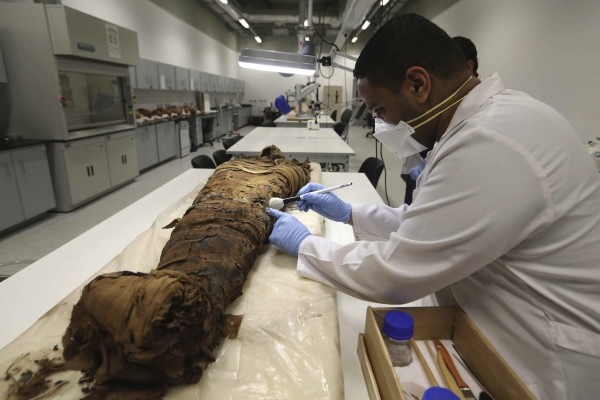Study Reveals Egyptian Mummification Started Earlier Than Expected
| Marc Maligalig | | Aug 14, 2014 11:34 AM EDT |
(Photo : Reuters)
Dr. Stephen Buckley from the University of York and Dr. Jana Jones have found combinations of embalming chemicals at Mostagedda, an archeological site that dates back to 6,000 B.C.
They said the linen wrappings were from ancient corpses found at Mostagedda, one of the earliest recorded Egyptian burial grounds
Like Us on Facebook
Dr. Jones said she has been fascinated over the past 10 years by information about early and mysterious ways of treating the deceased at the Neolithic burial grounds at Mostagedda and Badari.
In 2001, she was able to examine a few samples of funerary textiles from the sites that were sent from Egypt to numerous museums in the United Kingdom in the 1930s.
"Microscopic analysis with my colleague Ron Oldfield revealed resins were likely to have been used but I wasn't able to confirm my theories, or their full significance, without tapping into my York colleague's unique knowledge of ancient organic compounds," said Dr. Jones.
The combination of chemicals was identified by Dr. Buckley to be mix of a plant gum or sugar, a plant oil or animal fat, pine resin and a natural petroleum source.
The antibacterial characteristics of a few of the chemicals coupled with the preservation of localized soft-tissues led the team to conclude the preserved bodies were the origins of the mummification methods used in the Pharaonic period, Dr. Buckley said.
The blend of substances used as embalming agents contained antibacterial ingredients in the same proportion as those utilized by Egyptian embalmers at the peak of the mummification practice around 2,500 to 3,000 years later.
They were also akin to the standards used throughout the 3,000 year Pharaonic period in Egypt, he said.
TagsMummy, Egypt, Archaeology, Science, scientific research
©2015 Chinatopix All rights reserved. Do not reproduce without permission
EDITOR'S PICKS
-

Did the Trump administration just announce plans for a trade war with ‘hostile’ China and Russia?
-

US Senate passes Taiwan travel bill slammed by China
-

As Yan Sihong’s family grieves, here are other Chinese students who went missing abroad. Some have never been found
-

Beijing blasts Western critics who ‘smear China’ with the term sharp power
-

China Envoy Seeks to Defuse Tensions With U.S. as a Trade War Brews
-

Singapore's Deputy PM Provides Bitcoin Vote of Confidence Amid China's Blanket Bans
-

China warns investors over risks in overseas virtual currency trading
-

Chinese government most trustworthy: survey
-

Kashima Antlers On Course For Back-To-Back Titles
MOST POPULAR
LATEST NEWS
Zhou Yongkang: China's Former Security Chief Sentenced to Life in Prison

China's former Chief of the Ministry of Public Security, Zhou Yongkang, has been given a life sentence after he was found guilty of abusing his office, bribery and deliberately ... Full Article
TRENDING STORY

China Pork Prices Expected to Stabilize As The Supplies Recover

Elephone P9000 Smartphone is now on Sale on Amazon India

There's a Big Chance Cliffhangers Won't Still Be Resolved When Grey's Anatomy Season 13 Returns

Supreme Court Ruled on Samsung vs Apple Dispute for Patent Infringement

Microsoft Surface Pro 5 Rumors and Release Date: What is the Latest?










